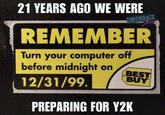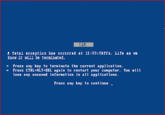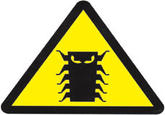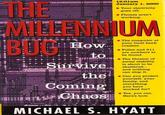Y2K Bug
This submission is currently being researched & evaluated!
You can help confirm this entry by contributing facts, media, and other evidence of notability and mutation.
Overview
The Y2K Bug, sometimes known as the Millennium Bug or Year 2000 Problem, was a result of digital storage using two-digit abbreviations for years in their systems. In the 1990s, many people were concerned that the rollover between December 31st, 1999 and January 1st, 2000 would result in mass computer failure.
Background
When computer languages were initially developed, coders opted to drop the "19" in years as a way to save some of the limited space they were given to work with.[1] This ideology was transferred to COBOL, a language created in 1959, which was used to program many of the world's personal computers. In the 1960s, an IBM programmer named Robert Bemer was helping a group from the Church of Jesus Chris of Latter-Day Saints with a genealogical research project[3] when he realized the first two year digits were necessary for dates in the seventeenth and eighteenth centuries. Bemer, who participated in developing ASCII and the process behind the Escape button helped develop a way to use a four digit reference code for years and became an avid proponent of implementing this throughout COBOL. He published warnings about the need for four digit year codes twice in the 1970s.[4]
The term "Y2K" was not coined until June 12th, 1995 when the Massachusetts-based programmer David Eddy suggested the term on the Year 2000 mailing list in lieu of Year 2000, Century Date Change and Faddle, among others.[5] By 1997, the mailing list had more than 16,000 subscribers[6] and was maintained by Peter de Jager, who also ran Year2000.com[7] as a hubsite for information on the possible bug.
Media Hype
The growing online concern about the Y2K bug garnered attention from the mainstream media, who were reporting more and more on the rapidly expanding internet community. The media's well-documented penchant for overhyping events fuelled public alarm at the Y2K bug. The media reports fuelled a storm of "prepping"; some members of the public, convinced that the global economy was on the brink of collapse, began stockpiling food and supplies. Some commercial survival kits were even manufactured.[1][9]


Government response
Even some governments decided to set up Y2K-related sites to reassure the public and to publicize contingency plans. Then-U.S. President Bill Clinton even addressed the issue in his 1999 State of the Union address:
"We need every State and local government, every business, large and small, to work with us to make sure that [the] Y2K computer bug will be remembered as the last headache of the 20th century, not the first crisis of the 21st."
The U.S. Government's official Y2K site was Y2K.gov[8]. It first went live in mid-1998, and featured contingency plans, as well as updates about the status of various resources, such as food, gas, and electricity. The government had a three-step approach which consisted of 1. outreach and advocacy, 2. monitoring and assessment, & 3. contingency planning and and regulation. The U.S. also passed the Year 2000 Information and Readiness Disclosure Act, which limited the liability of businesses which revealed their Y2K readiness[1] After it became apparent that the Y2K bug amounted to nothing, the site was rebranded as a clearinghouse for government Y2K-related information.
Search Interest
External References
[1] Wikipedia – Year 2000 Problem
[2] American Radio Works – The Surprising Legacy of Y2K
[3] Bob Bemer – Y2K: Computer glitch came as no surprise
[4] Boston Globe – Computer pioneer Bob Bemer; published Y2K warnings in '70s
[5] Slate – The Etymology of "Y2K"
[6] Year2000.com – Year 2000 Announcement List (archive from 7/1997)
[7] Year2000.com – Home (archive from 7/1997)
[8] Y2K.gov – Home (archive from 4/1999)
[9] Odd Culture – Bugging Out in 2000: The Y2K Problem














